We're sorry, but requests coming from your IP address seem to be automatic. For this reason, we are forced to temporarily block access to the search.
To continue your search, please enter the characters from the image in the input field and click Submit.
Cookies are disabled in your browser. Yandex will not be able to remember you and correctly identify you in the future. To enable cookies, follow the tips on our Help page.
Why did it happen?
Perhaps the automatic requests do not belong to you, but to another user accessing the network from the same IP address as you. You need to enter the characters in the form once, after which we will remember you and be able to distinguish you from other users coming out of this IP. In this case, the captcha page will not bother you for a long time.
Your browser may have add-ons installed that can set automatic search queries. In this case, we recommend that you disable them.
It is also possible that your computer is infected with a virus program that uses it to collect information. Maybe you should check your system for viruses.
If you have any problems or want to ask a question to our support team, please use the feedback form.
If automatic requests really come from your computer, and you know about it (for example, you need to send such requests to Yandex by type of activity), we recommend using a service specially designed for this purpose
Many potential buyers are sure that minimized Micro- and Mini-ITX computers are inferior and prefer ATX systems or laptops. But having bought a full-size case and the corresponding components, none of the owners can explain why 90% system block is empty. It turns out that somewhere the buyer made a miscalculation.
In this article, the reader is given the opportunity to get acquainted with a very attractive format of a personal computer, or rather, with its basic element - the motherboard. The buyer will learn not only the technical characteristics of the device, but also get acquainted with best models and see short review basic functionality. After all, Mini-ITX - motherboards, which today are considered the most popular in the computer market, which means that the next decade given format will stay in trend.
Specialized segment
There is nothing unique in the small size of the system unit. If you look at personal computers ten years ago, it turns out that the Mini-ITX format was quite in demand in the world market. Personal computers of this size have been used as office workstations, multimedia centers, and found themselves in home use.
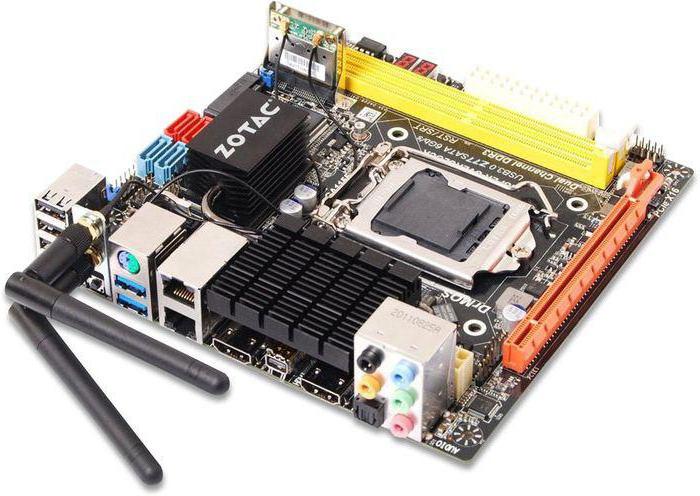
And there is no need to think that miniature motherboard form factors limit the owner in some way. In fact, even on the basis of Mini-ITX, you can even assemble Discomfort can be felt only by enthusiasts who prefer to overclock the components of the system unit. Yes, there can be problems with cooling in a miniature case.
Cores - pure emerald
And do not believe the media reports that miniature motherboards are created only for the Intel platform and have a limited series in the context of a single chip or core. As practice shows, in the domestic market Mini-ITX (motherboards) are much more common than the chips of the main competitor.
As for platforms, there are no restrictions on 1150, 1151, AM1, FM2. Also on the market you can find integrated solutions from by Intel, which offer a processor soldered into the motherboard. Naturally, the platform has support for both single-core processors and crystals with multiple cores.
entry-level segment
A fully integrated system will definitely be the most affordable system on the market, regardless of the chip that Mini-ITX (motherboards) are equipped with. The size does not play any role here, as does the power consumption of all components in the assembly. The low price is explained quite simply - the computer is difficult to improve. In fact, the user can only increase the volume random access memory and size hard drive. This is where the upgrade ends. The reader will agree that such a solution resembles a laptop.
![]()
On the other hand, the power supply of a Mini-ITX board tends to zero, so purchasing a personal computer with such motherboard, allows the user to save a lot of money cash. The maximum consumption of such a computer will not exceed 150-200 watts.
Office Solutions
In the low-cost segment, integrated motherboards based on the Intel Celeron processor with two cores have proven themselves well. Personal computers of this class are used in medium and large businesses and belong to the class of printing office equipment. The Mini-ITX case, at the request of the buyer, is equipped with a horizontal or vertical chassis, and can also be accompanied by a built-in optical drive.

As for brands, the choice here is quite large: AsRock, MSI, Gigabyte and Asus. There are no special differences between the products, the difference can only be in the number and type of memory modules. So manufacturers allowed themselves to use the SO-Dimm controller to save space on the motherboard. You can understand the negative feedback from the owners of such systems - memory for laptops is more expensive than a regular bar for desktop systems.
Available components market
Some Mini-ITX - motherboards based on an AMD chip - are considered by many buyers to be in the budget segment. The fact is that the devices have an attractive cost. However, the potential of such boards is much higher, because the manufacturer has tried to make a product that can satisfy even a demanding customer.
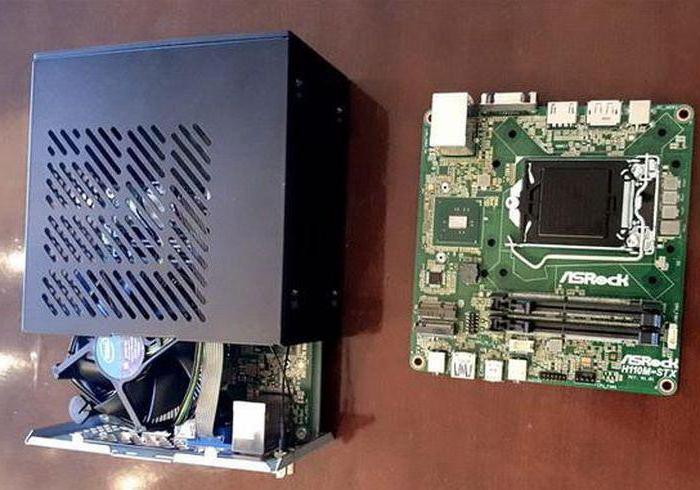
It's better to start with the fact that along with integrated network, audio and video adapters, the company's technologists have placed a full-fledged PCIex16 bus on the board. This means that a modern gaming graphics card can be installed in a small device case. Naturally, the potential of such a computer will directly depend on the processor in the system. There are no restrictions - you can even install a crystal with eight cores.
Home media server
Compactness, quiet operation and low power consumption are the three basic requirements that home users place on a vendor in the portable multimedia center market. If a small Mini-ITX case can satisfy the first two wishes, then consumption is often a problem, as most users are looking for a powerful motherboard and a powerful processor.
For multimedia, it is not the speed of the crystal that is more important, but rather the reaction of the hard drive to events and a large amount of RAM to operate data in real time. The Mini-ITX board should be the cheapest. But, together with integrated components, several modern memory controllers and an ultra-fast SATAIII interface should be provided on board.
The struggle for the mobile device market
Yes, gaming laptops have no competition in terms of portability, but when it comes to portability, many buyers have doubts. It is not hard to guess that the whole problem lies in decent cooling and the possibility of improving the basic components (processor and video card). So, miniature Mini-ITX - motherboards - are focused just on solving such problems.
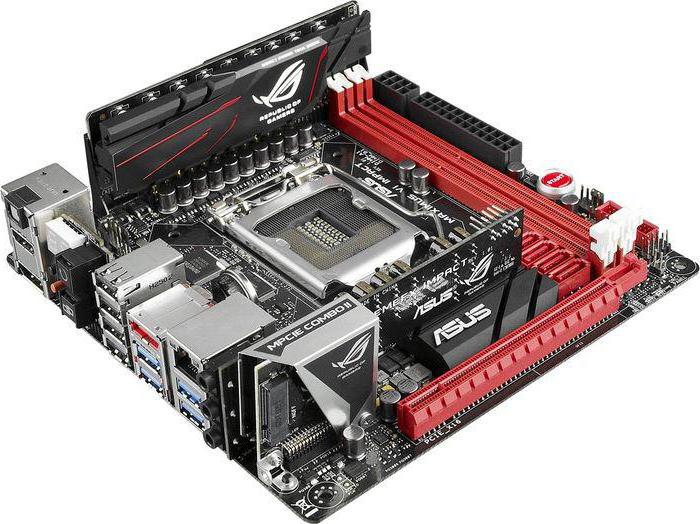
Naturally, the buyer will have a question about the potential of full-size ATX systems, which have better cooling and can be improved without any problems. However, the consumer will have to give up mobility. Therefore, it is so difficult to decide on the form factor before buying. As practice shows, Mini-ITX (motherboards) are a kind of compromise between a full-fledged computer and a laptop.
Everything is clear with the multimedia center - minimum dimensions, economical processor and a minimum of components in the device will allow the buyer to achieve their goals when buying. But fans of resource-intensive games who pay attention to compact personal computers will have to worry about the correct layout of the device. It is important here not to pile up motherboards with Mini-ITX format with unnecessary components so that the cooling system completely blows

It is better to give preference to modern processors with low power consumption (up to 65 watts), and also pay attention to the requirements of the video adapter. Do not forget about modern technologies in the form of SSD drives, as well as the presence of external optical drives which are available in the domestic market. The main task any player wishing to purchase an ITX system is to increase free space inside and reduce energy consumption together with heat dissipation.
Finally
There's no need to be under the illusion that motherboard form factors are segmented by performance. This is an erroneous opinion. Reducing the size of the system unit is caused only by ease of use, because often the majority desktop computers irrational use of space on the table or under it. This is where all the differences end.
Today, you will not surprise anyone with compact PCs - many manufacturers produce them. However, it is much more exciting to assemble a miniature car yourself. To do this, first of all, you need a case of a suitable size - we will write about them some other time - and a motherboard that fits into it. The mini-ITX form factor was designed especially for building small PCs. On the this moment There are a lot of motherboards of this standard on sale for different platforms.
Initially, the compact form factor was invented for the convenience of assembling low-power cold computers, such as embedded systems and thin clients. In this regard, motherboards with non-removable central processors soldered to them were the first to spread on the market. Such solutions are still popular and are not going to disappear. Today, in the vast majority of cases, they are equipped with energy-efficient stones. Intel Atom. At the same time, in conjunction with the Atom, both the Intel chipset and the more interesting NVIDIA Ion capabilities of the first and second generation can be used.
However, over time it turned out that more powerful compact computers would be useful to the people. Then some manufacturers of motherboards began to produce mini-ITX models with connectors for conventional desktop processors. Such motherboards are now in demand, and this is not surprising: the combination of good processing power and toy dimensions is impressive for many. Miniature motherboards exist for the LGA 1156 and AM3 platforms, as well as for the obsolete, but sufficient for some purposes LGA 775 and AM2 +.
Now, briefly about the capabilities of small-sized computers based on the motherboards discussed below. Systems based on Atom processors and Intel chipsets are designed to work either as office nettops or low-power servers. The first task does not require sprawling functionality, but requires a compact size and low heat generation. For the latter, it's nice to have RAID support as well, and some of these motherboards have it. Also, such platforms are useful for interacting with special equipment (scientific, commercial), since they are endowed with COM ports, and sometimes LPT.
The NVIDIA Ion and Ion 2 platforms differ from each other mainly in that the first supports older Atoms, while the second is friends with the N and D series. Otherwise, the difference between them is invisible to the nettop user. Both are designed to build energy-efficient media centers or powerful nettops. And NVIDIA's pricing policy for these chipsets turned out to be almost identical.
And finally, motherboards for full-fledged desktop stones can be used for any purpose, depending on the scope of your imagination, the size of the case and the heat dissipation of components, as well as your ingenuity and dexterity when assembling the system (smile). If desired and skill based on such a baby, you can create a workstation, and even a good computer for games. You just need to carefully consider the cooling device. Do not forget about the power organization of the system. The fact is that cases for miniature computers, as a rule, do not allow placing powerful power supplies in them. Therefore, we have to compromise: either the body is smaller, or the machine is more nimble.
- Processor: Intel Atom 330
- Chipset: NVIDIA Ion
- Network: Ethernet
- Details: www.asrock.ru
A typical-looking motherboard from the class of "ionic" systems, equipped with a traditional dual-core Atom 330 for such solutions, is designed to assemble an inexpensive and low-power media center. It is equipped with unobtrusive active cooling of the CPU and chipset. The built-in audio codec VIA VT2020 shows itself well, it introduces little distortion into the sound and will suit the vast majority of users.

Embedded video core (GeForce 9400M) helps low power processor to decode video high resolution. It is not very suitable for games, although it still allows you to display some undemanding toy on the Source engine in the 1336 x 768 mode. So play on the screen big TV you will succeed.
For the most fanatical overclockers, of those who can not leave even Atom in normal mode, a BIOS with a full set of functions is provided. Moreover, overclocking is really feasible and really speeds up the system! The stone holds 2.0 GHz and does not complain about instability, if you do not forget to slightly increase the voltage. If you are not sure how much to increase it, the BIOS can do it for you - automatic overclocking is decently implemented in it.
- Processor: Intel Atom D510
- Chipset: Intel NM10
- Interfaces: PCI, 2 x SATA II
- Memory slots: 2 x DDR2-800 (up to 8 GB)
- Network: Ethernet
- Features: COM, LPT
- Details: www.asrock.ru
This model has a lot in common with the previous test participant. Before us is a motherboard from the same company, and also with an Atom processor, and, most interestingly, with a similar BIOS. Yes, besides, this device also allows you to drive a low-power energy-efficient stone in the tail and mane.

However, there is also a significant difference between them. Chipsets and processors are used different. Intel's chipset doesn't have integrated video - it's relocated directly into stone. At the same time, the power of this video core (Intel GMA) leaves much to be desired - even with Full HD video display, the system cannot cope with it. Games are not even mentioned.
In addition, the previous mother supports DDR3 memory, and the AD510PV is friends with the time-tested DDR2 - however, this almost does not affect the speed of the system, just keep in mind when buying RAM (smile). Another important point: there is no PCIE interface here. But PCI can be useful, for example, to install a good sound card. Such a motherboard is an acceptable option for working with specific equipment with an LPT or COM interface. The AD510PV is also a good base for an office nettop. And you can also overclock the CPU to 2 GHz (smile).
- Processor: Intel Atom 330
- Chipset: NVIDIA Ion
- Interfaces: PCIE x16, 4 x SATA II (RAID 0 / 1)
- Memory slots: 2 x DDR3-1066 (up to 4 GB)
- Network: Ethernet, WiFi
- Details: www.asus.ru
It is curious that the price of this small motherboard reaches the cost of very serious overclocker-class motherboards. But if you consider that it comes with a remote control remote control, it's not so surprising anymore. In addition, it is equipped with Wi-Fi modules (moreover, it supports 802.11b / g / n standards) and Bluetooth. The board is unconditionally oriented towards building a media center on its basis.

This is noticeable both in the HDMI digital video output (DVI is implemented, if necessary, through an adapter), and in the sound jacks for a pair of "tulips" on the rear panel. The Realtek ALC887 audio codec allows you to output stereo sound suitable for listening through decent equipment. Separately, it is worth noting the completely passive, and therefore silent, cooling of the CPU and chipset. And with high-definition video, the Atom 330 + Ion set, as we already know, copes without problems. In addition to all of the above, the system has overclocking potential. The processor can be stabilized at a frequency of 2.2 GHz by raising the voltage to the maximum allowable 1.2 V. A special external power supply was placed in the box with the motherboard. It is better not to lose it, because it is difficult to find a replacement.
- Processor: Intel Atom D510
- Chipset: Intel NM10
- Interfaces: PCI, 2 x SATA II
- Network: Ethernet
- Features: COM, LPT
- Details: www.asus.ru
This is the most typical nettop motherboard with a dual-core "Atom" of the latest generation at the moment and a native Intel chipset. Such a set does not shine with an abundance of some exotic features, however, in the performance of ASUS, of course, it will please the user with stability.

Another reason for joy is again completely passive cooling. Having assembled a low-power, but small, cold and economical desktop computer based on this motherboard, you can start working on it without even installing the OS. The thing is that proprietary Express Gate technology is used here. Its essence is that a light operating system based on Linux.
Among the disadvantages of the device, one can note a small number of SATA ports and the inability to combine disks into a RAID array (it may still be necessary), which reduces its value as a basis for a server. However, do not forget that for the management of special equipment (for example, for car maintenance), systems with just such a modest set of capabilities are needed. By the way, the motherboard has a "younger sister" on the single-core Atom D410, and it costs a little less - keep in mind.
- Socket: AM3
- Chipset: AMD 880G
- Interfaces: PCIE x16, 3 x SATA II
- Memory slots: 2 x DDR2-800 (up to 4 GB)
- Network: Ethernet, WiFi
- Features: 2 x USB 3.0, Bluetooth
- Details: www.asus.ru
This unique product on the Russian market - a miniature motherboard with a full-fledged AM3 connector - is likely to have a great future. The fact is that not the fastest models of Athlon II and Phenom II processors are perhaps the most attractive for media centers. Their performance, despite being inferior to that of the Core iX, is significantly higher than that of the Atom, and the price is very low. Thus, a niche for miniature systems based on AMD stones has existed for a long time, and this motherboard fits perfectly into it.
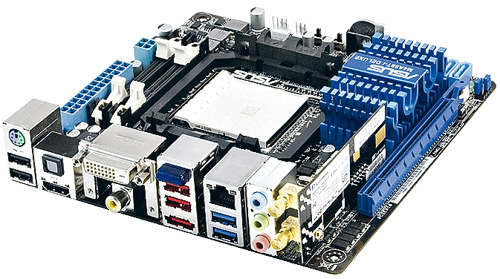
It is not deprived of functionality. Pay attention to Wi-Fi, Bluetooth and USB 3.0. In addition, it has a good video core built into the chipset with digital outputs and a high-quality audio codec. Those who intend to play resource-intensive games will like the presence of a slot for a discrete video card. The overclocking potential of the board, alas, is limited by the power of the stone's power subsystem - it produces a maximum of 95 watts. However, it is possible to try to unlock disabled cores in processors where they are available. So for compact media centers and machines general purpose option is very interesting. Note: This motherboard requires SODIMM laptop memory.
- Socket: LGA 1156
- Chipset: Intel H55
- Interfaces: PCIE x16, 4 x SATA II
- Network: Ethernet
- Features: hardware monitor
- Details: www.ecs.com.tw
A feature of all motherboards equipped with an LGA 1156 processor socket is that the video outputs do not always work on them. The fact is that chipsets for this platform, including the H55, do not have built-in video. The graphics chip is in CPU. But the trick is that not every stone under LGA 1156 has it. It is customary to supply them with not very productive dual-core Core iX models, while the “four-headed” Core i5 and i7 rely on a discrete video adapter. It is correct, because the power of the integrated graphics Intel cores below any criticism.

However, on this motherboard, in any case, there is a connector for an external video card. Given the very good overclocking capabilities, most likely, this is exactly what will be installed here. And the processor is likely to be used powerful enough, and the cooler is not the cheapest. But in this way it will be possible to assemble a small, but really gaming system. The BIOS of the motherboard allows you to adjust all the parameters important for performance. For its price, this device is more than an interesting offer. However, if you are ready to spend more money, but get more opportunities, read on.
- Processor: Intel Atom D525
- Chipset: Intel NM10
- Interfaces: PCI, 4 x SATA II (RAID 0 / 1 / JBOD)
- Memory slots: 2 x DDR3-800 (up to 4 GB)
- Network: Ethernet
- Details: www.gigabyte.ru
Now we know that not all motherboards based on the Intel NM10 chipset are the same. Each model has its own distinctive features. In this case, for example, not quite the usual "variety" of stone was used - it is 133 MHz faster than the traditional D510 for such systems. A trifle, but nice. The remaining features of this motherboard are mainly associated with Gigabyte's proprietary technologies. On such a modest bunch of “chipset + stone”, it would seem that you can’t really turn around. But no, it uses Ultra Durable 3 technology (reliable element base, double-thickness copper tracks) and soldered a backup BIOS chip. In addition, this motherboard can organize disk arrays. And it also has a decent audio codec installed.

Devices have few drawbacks, and they cannot be called critical. For example, it will not work to overclock the processor with it. The question arises: is it worth it to drive Atom at all? Moreover, the performance in games is not limited by the CPU, but by a very sluggish video core. You can scold the motherboard for a price that is slightly above average. On the other hand, the board is made with high quality, designed to last and will come in handy for many, at least for assembling mini-servers.
- Socket: LGA 1156
- Chipset: Intel H55
- Interfaces: PCIE x16, 4 x SATA II
- Memory slots: 2 x DDR3-1666 (up to 8 GB)
- Network: Ethernet
- Features: 2 x USB 3.0
- Details: www.gigabyte.ru
A few months ago, a detailed test report on this motherboard was published in our magazine, from which you could find out that the motherboard quietly keeps the reference frequency of 200 MHz. This means that there will be no problems with overclocking the CPU with its help - provided that an effective cooler is installed, of course. Its BIOS menu, by the way, is never inferior to that of many full-size motherboards.
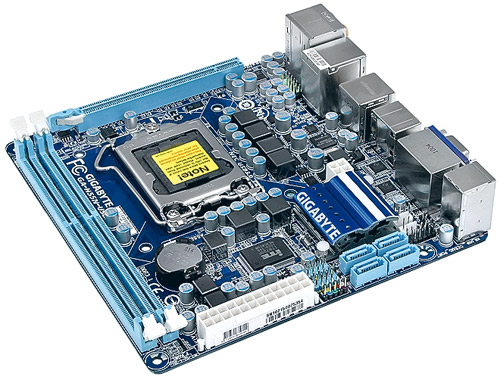
The motherboard willingly accepts any processors suitable for the socket, including the Core i5 and i7 with four cores. Support for fast memory also hints at the possibility of building a really fast miniature computer. By pairing a quad-core processor with a decent graphics card and providing sufficient cooling, it will be possible to play modern 3D games on such a system without brakes. The motherboard can also be used to assemble a media center - for this it is best to equip it with a dual-core stone, i3 or younger i5. And you can also assemble on its basis not a gaming, but a workstation - it will be an impressive machine! Perhaps, in terms of versatility, this motherboard surpasses even the solution considered above with the AM3 connector.
- Processor: Intel Atom D510
- Chipset: Intel NM10
- Interfaces: PCI, 2 x SATA II
- Memory slots: 2 x DDR2-800 (up to 4 GB)
- Network: Ethernet
- Features: mini-PCIE
- Details: www.intel.ru
The Intel motherboard is in some way a reference one - after all, both the processor and the chipset in this case are also produced by this company. In theory, it should be the most typical representative of the family. However, in practice, it turns out that its only feature similar to the rest of the devices in the review is the model of the installed processor. Otherwise, Intel's solution turned out to be very original.

The design of the board is harsh - it suggests an industrial or at least server purpose of the motherboard. But this, of course, is nonsense: the motherboard is more focused on the business segment. Chipset and processor cooling is completely passive, which is not a sin in this case, because the heat dissipation is small, and the heatsink is large. Its most interesting feature is the presence of a mini-PCIE expansion slot. Devices with a suitable interface are found in nature, although it cannot be said that often. The set of interfaces on the rear panel is quite ascetic - there is neither COM nor LPT, and there are only four USB ports. But both PS / 2 are in place. You can also notice a gigabit wired network interface connector and three audio jacks. It is not particularly worth outputting sound from them - the ALC662 codec is not of high quality.
- Socket: LGA 775
- Chipset: Intel G41
- Interfaces: PCI, 4 x SATA II
- Memory slots: 2 x DDR3-1066 (up to 4 GB)
- Network: Ethernet
- Features: Intel high definition Audio
- Details: www.intel.ru
Although at the moment the LGA 775 platform is already outdated, for many purposes its capabilities are enough, and even with a margin. Often, a processor from the Core 2 series can come in handy in a compact system based on a mini-ITX motherboard. For example, such stones are powerful enough to decode high-definition video without the help of a graphics processor, which means that they have an open road to media centers (especially since the sound on this motherboard is good, ALC888S).

At the same time, taking a more powerful Core 2 Quad, you can easily assemble a workstation based on this motherboard. In a word, the only thing that cannot be done on the basis of this motherboard is a gaming station. And all because there is no PCIE x16 slot for a fast discrete graphics card. The built-in video has a digital output, so the words about the media center or workstation are not an empty phrase: when the image is displayed on the monitor, its quality will not be lost. Please note: this is the only motherboard for this platform in the review. And she's very interesting. Owners of suitable processors will certainly appreciate it. And the rest will probably prefer the next heroine of the "Big Dough".
- Socket: LGA 1156
- Chipset: Intel H57
- Interfaces: PCIE x16, 4 x SATA II (RAID 0 / 1 / 5 / 10)
- Memory slots: 2 x DDR3-1333 (up to 8 GB)
- Network: Ethernet
- Details: www.intel.ru
The motherboard, despite belonging to a more modern platform than the previous test subject, is not as unambiguous as it might seem at first. First, it only supports dual-core processors. Unexpected, right? Secondly, there is an opportunity to increase the reference frequency in its BIOS, but the motherboard cannot raise the voltage on the stone. As a result, overclocking on it is feasible, but not strong. Another strange moment: the CPU cooler spins very slowly, and the stone gets very hot (up to 70°). No adjustments can make the fan rotate faster than three hundred and a few revolutions per minute. This also does not contribute to stability in emergency mode.

Despite all these disadvantages, the motherboard will certainly be in demand in the corporate segment. In the non-overclocked state, it works, of course, without any failures. In addition, on its basis, you can assemble a compact server, and already somewhat more powerful than on systems with an Atom processor. Also pay attention to the possibility of building RAID arrays. In a word, the thing turned out to be specific, not mainstream, but useful for some purposes.
- Socket: AM2+
- Chipset: NVIDIA GeForce 8200
- Interfaces: PCIE x1, 4 x SATA II (RAID 0/1)
- Memory slots: 2 x DDR2-1066 (up to 8 GB)
- Network: Ethernet, WiFi
- Details: www.zotac.com
Despite the obsolescence of the AM2+ platform, modern AMD processors quietly get into the appropriate slot due to backward compatibility. This can be used for selfish purposes - for example, by assembling a good, relatively powerful media center based on this motherboard. It is noteworthy that it supports Phenom II X4 with a 125 W TDP, which means that it is possible to make on its basis not only a multimedia computer, but also a very nimble workstation. But it will not work to assemble a gaming machine - unfortunately, there is no slot for a discrete graphics card.

At the same time, the PCIE x1 slot can be occupied, for example, with a high-quality sound system - then the compact machine will cope with the role of a media center even more convincingly. Concerning overclocking capabilities given device, they are present both in the BIOS and in practice, but, it seems to me, they will not be of much interest to the user of the board. You can work, watch movies in high resolution and listen to music at the regular frequency of the processor. In the same way, anyone who decides to make a mini-server on this motherboard is unlikely to drive a stone - in such tasks, reliability is much more important than a small increase
in speed.
- Socket: LGA 1156
- Chipset: Intel H55
- Interfaces: PCIE x16, 6 x SATA II
- Memory slots: 2 x DDR3-1333 (up to 8 GB)
- Network: Ethernet, WiFi
- Features: 14 USB ports
- Details: www.zotac.com
Again, this motherboard can be used to build a computer for virtually any purpose. Thanks to the PCIE x16 connector, it is ready to accept a good discrete video card, and even a Core i5 or i7 will fit into the processor socket. An impressive number of interface connectors will allow you to connect all the necessary devices. Six SATA ports are still all right (although rare with this form factor), but ten USB 2.0 sockets (plus four remote ones) are rarely found even on full-sized motherboards.

All of the above is accompanied by a pronounced ability to overclock processors, a BIOS with a full set of settings, and, finally, a Wi-Fi module. If you want to assemble a compact gaming machine, no problem. You want to organize a workstation - and this can be arranged. And, of course, multimedia capabilities in place, and the sound codec did not let us down - this is ALC888, and it sounds decent. The last nuance remains - to decide how justified the relatively high price of the device (one hundred and fifty US dollars). I think it's more justified than not. The Wi-Fi module is far from superfluous, free USB sockets also do not interfere, and overclockers BIOS settings may come in handy.
- Processor: Intel Atom 330
- Chipset: NVIDIA Ion
- Interfaces: 3 x SATA II (RAID 0 / 1 / 10)
- Memory slots: 2 x DDR2-800 (up to 4 GB)
- Network: Ethernet, WiFi
- Features: 10 USB ports
- Details: www.zotac.com
The main purpose of this platform is to be the basis of a media center. Please note that there are no expansion slots on this motherboard at all. More precisely, there is one exotic mini-PCIE standard, but it is already occupied by the Wi-Fi module. It is, however, for the better, because the benefits of the adapter wireless network often much more than from an ever-empty slot for an expansion card.

The motherboard and processor are fed from a compact outdoor unit nutrition. They can play high-definition video and music. The last motherboard, like many others in the review of those that are more expensive, can output via S / P-DIF. Another feature, for some reason implemented in almost all systems based on Atom processors, is overclocking. The CPU manages, by slightly raising the voltage, to stabilize at around 2.0 GHz. And this continent allows the user to combine disks into arrays. The price of the device, for all its sprawling functionality, seems overpriced. And all because a competing company for the same money with the same system also offers a media center control panel. And this remote, to be honest, is a weighty argument.
- Processor: Intel Atom D510
- Chipset: Intel NM10
- Interfaces: PCIE x1, 2 x SATA II
- Memory slots: 2 x DDR2-800 (up to 4 GB)
- Network: Ethernet, WiFi
- Features: mini-PCIE
- Details: www.zotac.com
The first feature of this device that you immediately pay attention to is the presence of a Wi-Fi module (it supports b / g / n standards). In itself, its presence is not typical for motherboards based on the NM10 chipset. Then you notice that it occupies one of the mini-PCIE slots, and the second one is just as free - which means you can install something there. Then you begin to see the already familiar features of a well-known platform. Atom D510 under a hefty, completely passive heatsink, a couple of SATA sockets, one PCIE x1 slot - if you wish, you can take it with a discrete audio card ...
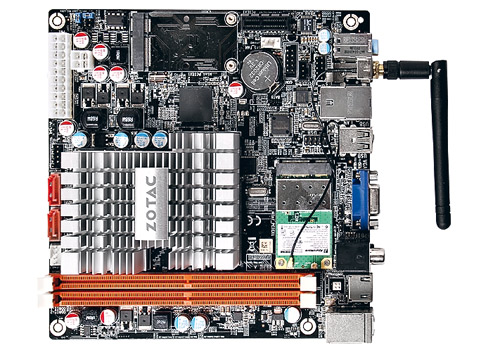
Why, by and large, you need a wireless network adapter built into the nettop motherboard, this is another question. But some will definitely like this solution. In other aspects, the motherboard is standard for its class, except that it stands out with Zotac's proprietary design - compare with the previous ones and notice it yourself. Although there is another curious feature - the presence of an HDMI output. Often, on the Atom + NM10 platform, only analog video output is made. And one more thing: there are no outdated COM and LPT interfaces on the rear panel, so it is better to make a computer for working with special equipment based on another motherboard.
conclusions
Little by little, compact-sized motherboards are turning from exotic devices for purely special purposes into a common, mass commodity. Their necessity and applicability are no longer in doubt among the "end-user". As already mentioned in the introduction, the tasks that can be solved with the help of this specific model mini-ITX motherboards depend on their design.
However, it's not just about what chipset the motherboard is based on. And the fact that modern chipsets often have a wide range of features, of which only a few can be used on a mini-matplata - there is simply not enough space for everything. Concerning different models on the same chipset may differ from each other in the set of functions and purpose. The most interesting, in my opinion, models are universal - based on them, you can make an HTPC (Home Theater Personal Computer, in Russian - a media center or a PC for a home theater), a workstation, and a gaming machine. These are required to meet certain requirements. Firstly, the processor cannot be embedded - the motherboard should have a socket for a standard desktop gem. Secondly, there must be a slot for a video card, otherwise the workstation will succeed, but the gaming one will not. And thirdly, it is desirable that the motherboard has really working tools for overclocking processors.
Of particular interest are the options on the basis of which you can make a mini-server, NAS, Internet gateway and similar small but extremely useful devices. Such platforms must be cool, silent, reliable and inexpensive. Everything that can be said about media centers on the Ion platform has already been said, there is no need to repeat it. So, what should you pay attention to when purchasing such a motherboard? The first is for the presence of the necessary interfaces (a slot for a video card, a sufficient number of SATA and USB ports, etc.). Secondly, on the type of memory supported. Thirdly, you should check the list of compatible processors before buying a stone. And finally, when deciding to choose a mini-system, it is worth looking at a compact, beautiful and well-ventilated case of a suitable form factor. But this is a topic for a separate discussion. We will definitely address it in the near future. U.P.
That the leading Taiwanese manufacturers have taken seriously the creation of Mini-ITX devices suitable for gamers and overclockers. Today we will be convinced of this once again, because comparative testing is devoted to choosing a motherboard for a small but powerful gaming computer with modern processor Intel Kaby Lake and a full-fledged discrete graphics card. In addition, there are a lot of interesting miniature cases on sale, powerful power supplies of the SFX form factor are becoming increasingly popular, and some manufacturers are releasing special shortened versions of 3D accelerators. The matter remains small: decide on the list of components and assemble your own gaming computer dreams.
The Mini-ITX format is not as popular as the same mATX and ATX, but there is something to “profit” here. I turned to the Regard computer store for help and took all the Mini-ITX boards based on the Z270 Express chipset that were on sale at that time. All six devices are quite suitable for the task outlined in the article - creating a productive, but compact gaming system unit. It remains to identify the strengths and weaknesses of each of the test participants.

Mini-ITX form factor motherboards do not support arrays AMD graphics cards and NVIDIA, since they are equipped with only one PEG port. A connector for drives (including Intel Optane) M.2, to which four PCI Express 3.0 lanes are connected, is available in all solutions based on the 200th logic. It turns out that the Z270 Express is interesting only because of overclocking and high-frequency RAM. In all other cases, boards based on the low-end H270 Express logic will have exactly the same functionality, but at the same time cost less. Motherboards based on the Z170 Express chipset are also compatible with Kaby processors Lake and provide for the possibility of overclocking. The reasons why you should still prefer a board based on a more modern 200th logic,.
The onboard memory controller of Skylake and Kaby Lake processors supports up to 64 GB of DDR4 RAM, but since Mini-ITX boards have only two DIMM ports, the maximum amount of RAM is 32 GB.
⇡ Specifications and equipment
All six devices have similar features and functionality. For example, each board has a Wi-Fi and Bluetooth wireless module. The differences lie in the different number of ports such as M.2, SATA 6 Gb / s, RJ-45 and USB. Full list The characteristics of the considered motherboards are given in the table.
| ASRock Z270M-ITX/ac | ASUS ROG Strix Z270I Gaming | GIGABYTE GA-Z270N-Gaming 5 | GIGABYTE GA-Z270N-WIFI | MSI Z270I GAMING PRO CARBON AC | ||
|---|---|---|---|---|---|---|
| CPU | Intel Core i7/Core i5/Core i3/Pentium/Celeron 6th and 7th Gen LGA1151 (Skylake-S and Kaby Lake-S) | |||||
| Chipset | Z270 Express | Z270 Express | Z270 Express | Z270 Express | Z270 Express | Z270 Express |
| Memory Subsystem | 2 × DIMM, up to 32 GB DDR4-2133-4000(OC) |
2 × DIMM, up to 32 GB DDR4-2133-3733(OC) |
2 × DIMM, up to 32 GB DDR4-2133-4266(OC) |
2 × DIMM, up to 32 GB DDR4-2133-4000(OC) |
2 × DIMM, up to 32 GB DDR4-2133-4000(OC) |
2 × DIMM, up to 32 GB DDR4-2133-3800(OC) |
| Expansion slots | 1 x PCI Express x16 3.0 | 1 x PCI Express x16 3.0 | 1 x PCI Express x16 3.0 | 1 x PCI Express x16 3.0 | 1 x PCI Express x16 3.0 | 1 x PCI Express x16 3.0 |
| Drive interfaces | 4 x SATA 6Gb/s 1 × SATA Express 10Gb/s |
1 × M.2 (Socket 3, 2230/2242/2260/2280) supporting SATA and PCI Express x4 6 x SATA 6Gb/s |
1 × M.2 (Socket 3, 2242/2260/2280) with PCI Express x4 support 4 x SATA 6Gb/s |
1 × M.2 (Socket 3, 2260/2280) with SATA and PCI Express x4 support 4 x SATA 6Gb/s |
1 × M.2 (Socket 3, 2260/2280) with SATA and PCI Express x4 support 6 x SATA 6Gb/s |
1 × M.2 (Socket 3, 2242/2260/2280) with SATA and PCI Express x4 support 4 x SATA 6Gb/s |
| RAID 0, 1, 5, 10 | RAID 0, 1, 5, 10 | RAID 0, 1, 5, 10 | RAID 0, 1, 5, 10 | RAID 0, 1, 5, 10 | RAID 0, 1, 5, 10 | |
| The local network | 1 × Intel I219V, 10/100/1000 Mbps | 1 × Intel I219V, 10/100/1000 Mbps | 1 x Intel I219V 10/100/1000Mbps 1 x Intel I211V 10/100/1000Mbps | 1 × Intel I219V, 10/100/1000 Mbps | ||
| Wireless network | IEEE 802.11a/b/g/n/ac + Bluetooth 4.0 | IEEE 802.11a/b/g/n/ac + Bluetooth 4.1 | IEEE 802.11a/b/g/n/ac + Bluetooth 4.2 | IEEE 802.11a/b/g/n/ac + Bluetooth 4.2 | ||
| Audio subsystem | Realtek ALC1220 7.1 HD | Realtek ALC892 7.1 HD | Realtek ALC1220 7.1 HD | Realtek ALC1220 7.1 HD | Realtek ALC1220 7.1 HD | Realtek ALC1220 7.1 HD |
| Interfaces on the rear panel | 1 x PS/2 1 x Display Port 1 x HDMI 1 x RJ-45 1 x Thunderbolt 3 6 x USB 3.0 Type A 1 × S/PDIF Opt out 6 × Audio 3.5mm 2×SMA |
1 x PS/2 1 x DVI-D 2 x HDMI 2 x RJ-45 6 x USB 3.0 Type A 2 x USB 2.0 Type A 3 × Audio 3.5mm 2×SMA |
1 x Display Port 1 x HDMI 1 x RJ-45 3 x USB 3.0 Type A 1 x USB 3.0 Type C 4 x USB 2.0 Type A 5 × Audio 3.5mm 2×SMA |
1 x PS/2 1 x Display Port 1 x HDMI 1 x RJ-45 4 x USB 3.0 Type A 1 x USB 3.1 Type A 1 x USB 3.1 Type C 6 × Audio 3.5mm 2×SMA |
1 x PS/2 1 x DVI-D 2 x HDMI 2 x RJ-45 4 x USB 3.0 Type A 1 x USB 3.0 Type C 1 × S/PDIF Opt out 5 × Audio 3.5mm 2×SMA |
1 x PS/2 1 x Display Port 1 x HDMI 1 x RJ-45 2 x USB 3.0 Type A 1 x USB 3.1 Type A 1 x USB 3.1 Type C 2 x USB 2.0 Type A 1 × S/PDIF Opt out 6 × Audio 3.5mm 2×SMA |
| Form factor | mini-ITX, 170x170mm | mini-ITX, 170x170mm | mini-ITX, 170x170mm | mini-ITX, 170x170mm | mini-ITX, 170x170mm | mini-ITX, 170x170mm |
| Price | ~12 500 rub. | ~8 500 rub. | ~13 000 rub. | ~12 500 rub. | ~9 500 rub. | ~12 500 rub. |
All tested models are packed in small cardboard boxes. In most cases, the delivery set is standard - a plug for the I / O panel, SATA cables, antennas for the wireless communication module, waste paper (user manual, stickers, advertising brochures, coasters for beer glasses), as well as a disk with drivers and software. The ASUS ROG Strix Z270I Gaming package stands out a little, which, in addition to the above, has a couple of really useful things: extension cords for connecting case controls and RGB tape. It is worth noting the MSI Z270I GAMING PRO CARBON AC, which in the box also found an 800 mm extension cable with a splitter for connecting two LED strips.

The ASRock motherboard lineup includes an impressive number of different series. Including the Fatal1ty series, named after the famous American e-sportsman Jonathan Wendell, which appeared in the company's assortment seven years ago.

I have already noted that all six devices have a similar layout of the main elements, so when analyzing the interface wiring, it remains only to pay attention to all sorts of little things. For example, the Fatal1ty Z270 Gaming-ITX/ac has all three four-pin fan headers on the same (top) side. If you use the board in a Slim Desktop format ( , SilverStone RVZ02, Lian Li PC-O5X), this arrangement may be inconvenient. For example, when installing a pair of 120mm fans for additional cooling of the graphics adapter in the Fractal Design Node 202, you will need to look towards models that have wires no shorter than 20 centimeters. Or connect them using an adapter connected to the MOLEX connector of the power supply. Unfortunately, this model cannot control fan speed without PWM.
But on the printed circuit board, the internal USB interfaces 2.0 and USB 3.0. This arrangement is convenient both in the case of using the Slim Desktop and Mini-Tower case (, NZXT Manta, Phanteks Enthoo Evolv ITX). In addition to the listed interfaces, it is worth noting the ability to connect 3.5 mm audio jacks on the front or top panel of the case.
The PCI Express x16 connector is additionally reinforced. This technology used in five motherboards of the six considered. The manufacturer notes that the contacts of the PEG-port and DIMM slots received gold plating. The Fatal1ty Z270 Gaming-ITX/ac does not have a backlight, and there is no connector for connecting an RGB tape.
The Intel I219V gigabit controller is responsible for the wired connection - a frequent guest in many Z270 boards more expensive than 10,000 rubles. Per wireless connection the Intel Wireless-AC 7265NGW module is responsible. V GIGABYTE boards and MSI, reviewed in this article, use the integrated Intel Wireless-AC 8265NGW card, it is also installed in a separate M.2 (Key E) slot. The modules provide an IEEE 802.11a/b/g/n/ac wireless connection with maximum throughput up to 867 Mbps. The differences lie not only in the support of one or another version of Bluetooth (Wireless-AC 7265NGW has Bluetooth 4.0, Wireless-AC 8265NGW has Bluetooth 4.2), but also in the method of spatial coding of the MU-MIMO signal, which is supported by a more modern version wireless adapter Intel.

The layout of the elements of the Fatal1ty Z270 Gaming-ITX/ac is quite dense, the chipset cooling radiator takes up a lot of space. Four SATA 6 Gb / s ports are soldered between it and the DIMM sockets - not a very good solution, since it is not even the largest CPU cooler cover at least two blocks. As a result, the lack of space led to the fact that the M.2 slot for installation solid state drive“moved” to the back of the PCB - this is a common solution for mini-ITX boards. 2260 and 2280 SSD formats are supported. When using M.2 in SATA mode, the SATA3_0 connector is disabled.
The SSD is mounted directly under the chipset. Taking into account the fact that modern NVMe drives sometimes heat up to 70-80 degrees Celsius under a serious load (and the old ones even up to 100 degrees Celsius), it turned out not the best solution. For example, the Slim Desktop case will use Down Flow CPU cooling. Therefore, if there is an SSD on the back side, it will not be additionally blown. Under such conditions, the NVMe drive may overheat, resulting in a drop in its performance. Also, keep in mind that not all SSDs with additional cooling (for example, Team TForce Cardea) will fit in the opening between the case and the board.
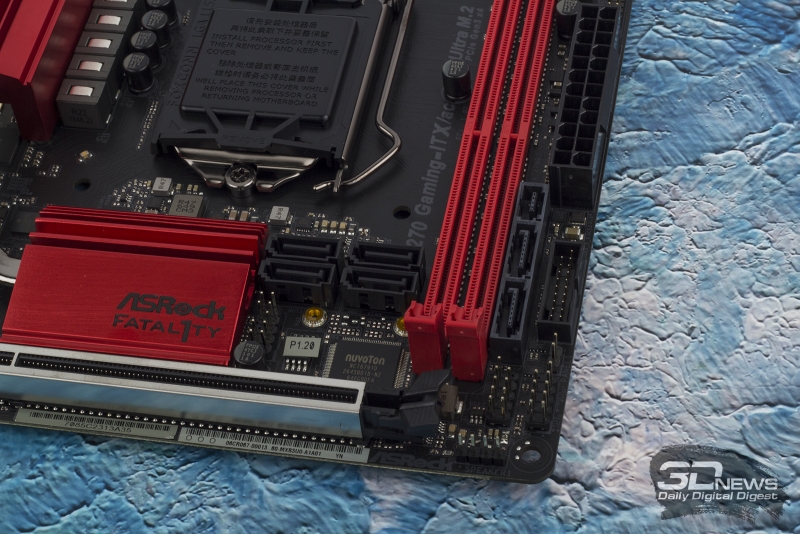
The board in question is the only one in the test that uses the SATA Express interface. The interface is dead, there are no running models for sale, and there is no need for them if you have M.2 with four PCI Express 3.0 lanes. So in 100% of cases, SATA Express will be used as two simple SATA 6 Gb / s.
The most notable port located on the I / O panel is Thunderbolt 3. It also acts as USB 3.1 Type-C, and you can connect a display to it. The interface is implemented using Intel JHL6240 and Texas Instruments TPS65982 controllers. Otherwise, the set of I/O ports is fairly standard for boards based on the Z270 Express. I will only note that next to the SMA connectors to which the antennas from the Intel wireless module are connected, there is a BIOS reset button.
You know, there is a type of computer whose main task is to watch movies / TV shows, work a little, and also to occasionally “shake” the old days, and start playing some The Elder Scrolls Morrowind, or Warcraft 3, or that - same CS 1.6. And if once upon a time it was necessary to assemble a whole computer, with a case, with a power supply, a motherboard and all other parts of the system, then in modern realities all of the above is the last century. In addition, more and more often small and powerful systems are being integrated into cars, tables and other parts of the interior, which means that an extremely compact solution is needed.
The thinning of the technical process, the optimization of architectures, and so on and so forth, made it possible to reduce the power consumption of various microcircuits individually and of the entire system as a whole many times over. Therefore, more and more PCs with the prefix “mini” have appeared on the market lately. For such mini-PCs, there are motherboards, like the recently introduced ASUS UN66, which has performance that does not correspond to its own size (in a good sense of the word).

In the next few pages, we'll take a closer look at what can be placed on a 4x4 board and what the board is capable of.
Appearance and features
The first thing to start with is the size. It's not every day that you manage to hold a board with dimensions of 102x102 in your hands, on which there is so much and so little at the same time, no matter how it sounds. Just imagine, in these 300 g (including two slats of RAM and an M.2 SSD drive) a really full-fledged computer with Windows 10 fit in.
The second thing to continue with is the body, which does not exist.

ASUS UN66 comes with various pre-installed processors. There is a choice of Intel Core i3-6100U (2 cores / 4 threads and frequency up to 2.3 GHz), Core i5-6200U (2 cores / 4 threads and frequency up to 2.8 GHz) and Core i7-6500U (2 cores / 4 streams and frequency up to 3.1GHz). The most top-end version fell into our hands, the “heart” of which is core processor i7-6500U Skylake generation. And note that the CPU is soldered on a PCB. It cannot be simply removed and replaced with another one.
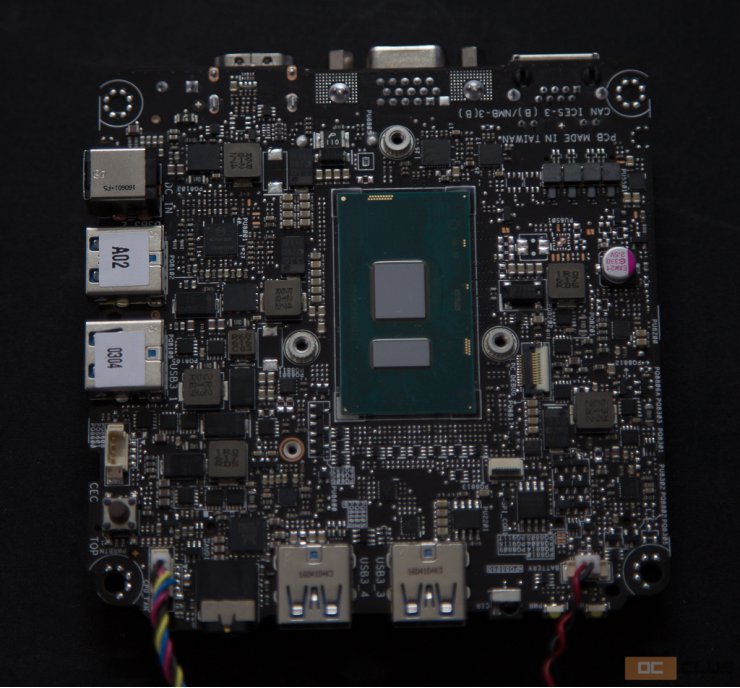
Of course, the i7-6500U has a “U” suffix, which means it belongs to the line with the lowest power consumption, which are also used in netbooks and ultrabooks, and cannot be compared with a full-fledged desktop Core i7. It only has two cores, much less than the L3 cache (4MB to be exact), but it also resulted in a measly 15W TDP.
With all this, a relatively powerful Intel HD Graphics 520 graphics chip, which is capable of operating at frequencies up to 1.05 GHz, is soldered on the same substrate with the CPU chip. There is support for DirectX12, and even 4K displays, and in general this video core is quite capable of providing a more or less decent level of fps, albeit not in the newest games. There are no problems in video playback of any resolution either.

But back to the board itself. It may not be that big, but there was space for everything you need. Two slots for DDR4 SO-DIMM RAM are soldered on the PCB, which allows you to install up to 32 GB of RAM (frequency up to 2133 MHz). To connect drives, there is a SATA 6 Gb / s port, and another M.2. The M.2 slot accepts a 42mm or 80mm drive (type 2242 and 2280).
There is also another M.2 slot, but it is exclusively for the wireless module. WiFi connections or BT.

In fact, there are a lot of different interfaces here. In addition to the above, the novelty is equipped with an IR sensor, two unusual ports that can receive a signal from any sensors such as GPIO, SMBus, I2C and DMIC, and another pin serial port (aka COM port). Love - to the grave, a tattoo - 2 months longer, and the COM port is immortal.

In 99% of cases, a typical user does not need all this, with the exception of an infrared port for remote control from a remote control, but all this will be valuable in other areas. For example, ASUS UN66 can be used as a home multimedia system, as a basis for various machines, and even just as a node for surveillance cameras. In general, the scope of the "baby" is very wide.

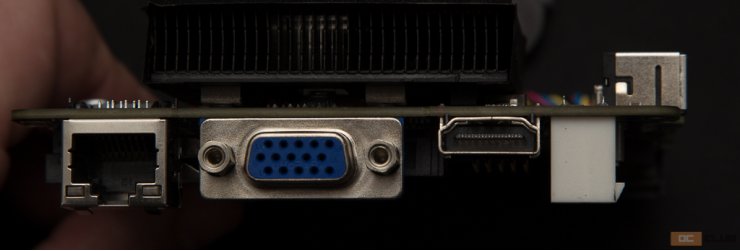
And, of course, the mini-board is simply studded on all sides with I / O ports. soldered four USB port 3.0, HDMI and VGA video outputs, one 3.5mm universal audio jack, and a gigabit network port.

ASUS specifically notes that on USB ports 3.0, increased current can be supplied, which allows you to charge your gadget twice as fast as from conventional USB ports. I won’t name the exact numbers, but the phone charged faster from them.

The whole thing is powered by an external power supply with a voltage of 19 V and a current of 3.42 A, which gives a total power of 65 watts. These power supplies are very common. In fact, the specifications are like those of a laptop. In the event of unforeseen circumstances, such as a wire gnawed by pets, a replacement will be easy to find.

And in conclusion of the chapter, a few words about the cooling system. Like the whole board, the cooling system is small. A small aluminum heatsink with a copper evaporative chamber at the base, and a 55mm turbine-type fan.
In general, the Carlson is capable of spinning over 3500 rpm, but, surprisingly, even at such speeds you can’t call it noisy. Listen to how the laptop makes noise. That's about the same noise and ASUS VivoMini UN66.
Test results
First, traditional CPU-Z screenshots:

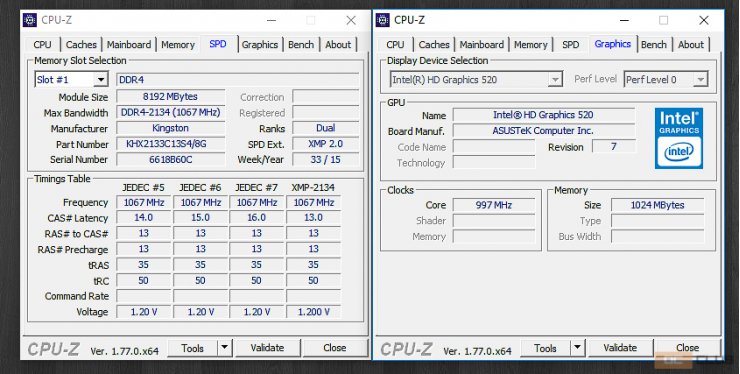
We installed two Kingston SO-DIMM DDR4-2133 memory modules on the board, which worked at an effective frequency of 1066 MHz, and the total volume of which was 16 GB, which will be enough in the vast majority of cases.
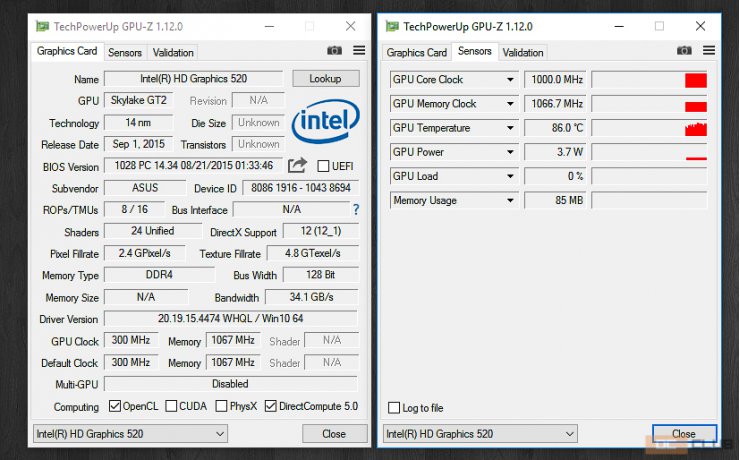
The TechPowerUp GPU-Z utility version 1.12.0 determined all the indicators correctly, but the temperature of the graphics core on the tab with sensors immediately catches the eye. 86 ° C - not to say that this is not enough, and this is without load. In reality, the GPU-Z sensor is wrong. Mostly the temperature stayed around 60-70 degrees, which will be seen in some of the other benchmarks.
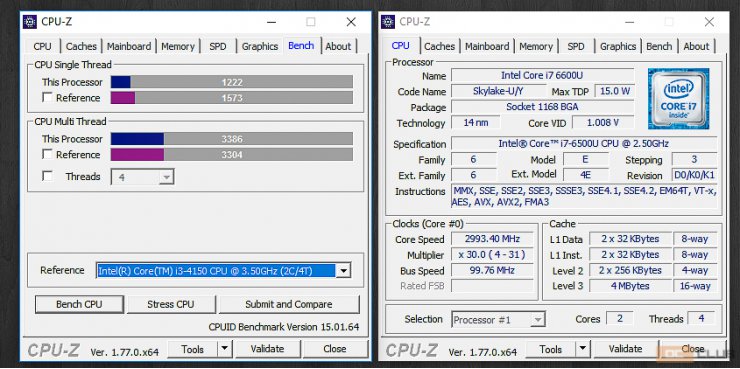

In the CPU-Z benchmark Intel processor The Core i7-6500U shows results roughly similar to the desktop Core i3-4150. There is a slight lag in single-threaded mode, but in multi-threaded mode the results are extremely close.


In tests of AIDA64 memory performance, the speed is quite consistent with the memory frequency. Actually, nothing else was expected.
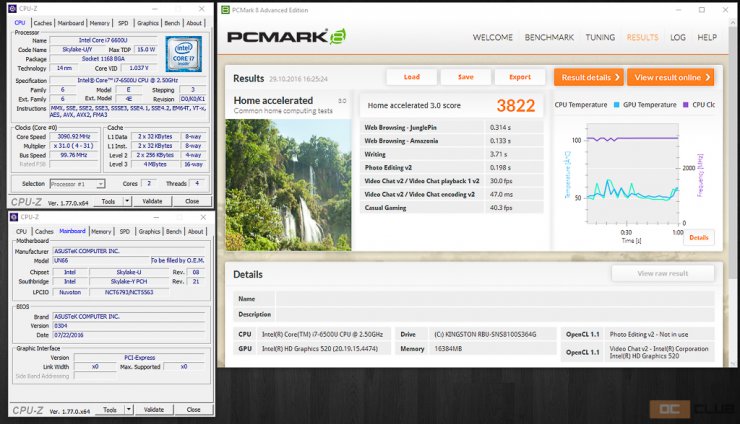
PCMark 8 evaluates the overall performance of the system in a variety of tasks, including performance in the browser, video playback, and performance in not too demanding games. It is also worth looking at the temperature graphs on the right side of the screenshot. During the entire testing in PCMark 8, the temperature of the CPU and GPU did not rise above 67 ° C, so in everyday tasks the processor will almost always work at a frequency increased to 3.1 GHz.
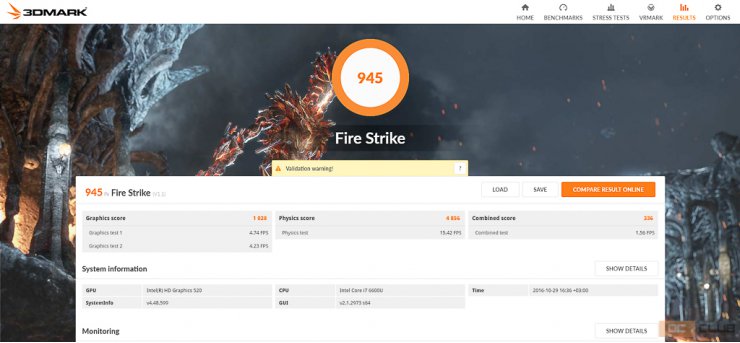

And, of course, 3D Mark FireStrike and Time Spy tests. In them, the built-in video core is not as efficient as a separate video card with its own video memory, but no one expected super performance.

Finally Catzilla. From Catzilla, the mini PC based on ASUS UN66 received the rank of “KITTY” and 3410 points.
conclusions
ASUS UN66 is practically a Schrödinger board. Such a mini-PC can be recommended to everyone at the same time, and at the same time to no one. If you need a computer for simple tasks, but so that it performs them well, after all, the Core i7-6500U can do something - then UN66 great choice. In addition, it will even be possible to let a stingy short-sighted tear of a geek into some legendary and old game, and even say: they used to make games with soul! And you will not believe it, but I was even able to run Crysis 2 on it.
Moreover, a wide range of specific connectors allows you to use this "boy" in other tasks, and the range of these tasks is huge. As a PC for the office - the solution is almost perfect.

Theoretically, the novelty is even very reliable. Indeed, on a 4x4-inch board, there are simply fewer elements that can break.
The conclusion this time is doubly complicated by the fact that, at the time of writing, ASUS review UN66 is not for sale yet, and even its price is unknown, and the review that is in front of you is the first on the Internet. By the start of sales, a version will appear in a branded case, for sale in the finished PC segment, and not just for enthusiasts.
Pros:
- compactness
- Small power consumption
- Availability of specific interfaces
- Powerful enough hardware, on which you can even play
